Over the years, I read more books and expanded my knowledge of the heavens. Senior-level students in my high school had to write a long, detailed term-paper as a "final project," and mine was about black holes. As a young adult years later, I met someone who shared my passion for star-gazing and we became friends. The two of us star-gazed together on numerous occasions. He had a really good telescope which he had built, himself. He had taken an old cardboard tube in which carpet had been shipped, bought a mirror from a mail-order company that sold astronomical supplies, mounted it in the tube, and then built a frame from scrap wood to hold the tube. With the purchase of a rack-and-pinion focuser and a couple of eyepieces from the supply shop, he had a great do-it-yourself telescope that was much cheaper than a ready-to-use telescope would have cost!
He finally decided he wanted a slightly bigger one (with an 8" / 20cm) mirror, so he sold his original 6" / 15cm f/5 telescope to me. We star-gazed with them often, looking at the rings of Saturn, details in the clouds of Jupiter and the surface of Mars, nebulae, galaxies, double-stars, and all sorts of wonderful things! Several other people wanted to join us, so he and I started our own astronomy club in the area. I wrote a monthly newsletter for the club, and we had much fun together over the years. We hosted several star-gazes where the public was invited to attend, and numerous Comet Halley parties when the comet came close to Earth back in the 1980s. The local television station even interviewed me during that time, and I appeared in a two-to-three minute segment on the news about the comet... LOL! We also hosted events for solar and lunar eclipses. I finally moved away from the area, but last I heard, the club was still thriving, but under a different name with the new leadership.
I finally sold that telescope to a friend and down-sized to a smaller, more portable telescope, which I only use on rare occasions nowadays (partly because I am always on Steemit and Discord... LOL). For anyone curious, it is an Astroscan and is — quite literally — no larger than a backpack.
A couple of weeks ago, I mentioned how the planet Venus is currently appearing as a bright "Evening Star" in the sky shortly after sunset (read more in my 'Venus, Evening Star' post). Those who wish to see more planets can do so, as there are three other bright ones that appear as the night progresses!
While Venus is still slowly setting in the west, one can look towards the south and see another bright star-like object that is the planet Jupiter. Further towards the east is the planet Saturn, making a lovely arc with the other two. Jupiter is not quite as bright as Venus, but is still brighter than most of the other stars. Saturn is not quite as bright as Jupiter, but still rather bright.

• SCREENSHOT FROM STELLARIUM •
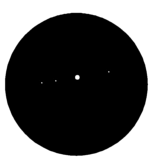
As these four moons orbit the giant planet, they can be seen to shift in position. If one observes them and marks their position in a drawing on a piece of paper, then observes them a few hours later or the following night, the change in position is easily evident! This activity can be fun for an adult, but is also a great teaching experience for children.
Saturn is famous for the rings surrounding it, but those cannot be seen in binoculars; a telescope is required. The same as Jupiter, Saturn also has dozens of moons orbiting it. Only one of Saturn's moons, however, is visible in binoculars and backyard telescopes. That moon is named Titan, and is easily visible as a small "star" near the planet in a similar fashion to Jupiter's Galilean Moons.
Once Venus has set, Jupiter and Saturn will have climbed higher into the sky. Following them in the celestial parade is Mars, the planet that is more like Earth than any other planet in our solar system. Mars has two moons, but neither are visible in binoculars. Because of the coloring of the soil on Mars, the light reflected from it is reddish-orange in color, so Mars is easily identified by a lovely orange glow. It has been especially pretty — breathtaking, actually — in recent nights when I have seen it!
Since all the planets are orbiting the sun, their positions will change with respect to the stars as time passes. So, the positions shown in this post are only what is seen during July 2018. Anyone coming back to this post months or years from now will find the planets in different positions. Those different positions can easily be found in sky maps or via "planetarium software" such as I mention at the end of this post.
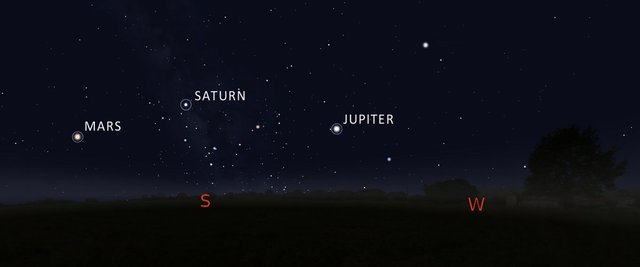
• SCREENSHOT FROM STELLARIUM •

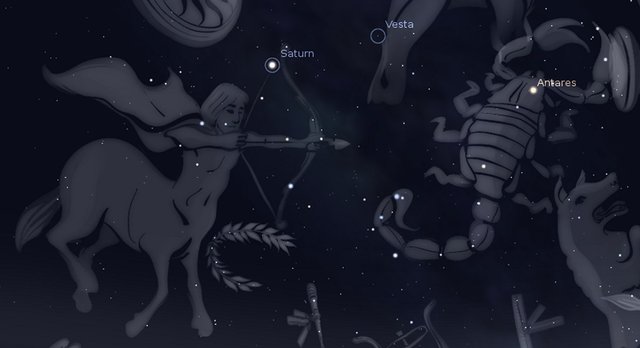
• SCREENSHOT FROM STELLARIUM •
- Astronomy is the scientific study of the universe, the stars, the planets, their motions, and their physical attributes. Astronomers try to determine how far away objects are, what chemical elements they're made of, how their gravitational pull affects the others, and so forth. Astronomy concerns itself with facts.
- Astrology is the belief that hidden secrets to human personality and world events can be decoded from the positions of the stars and planets at a given time. Astrology is a belief system which may, or may not, have validity and is experiential in nature on a personal level.
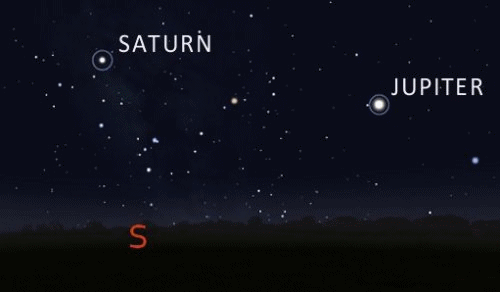
The brightest star in the constellation of Scorpius is Antares, which means "Rival to Mars" because the brightness and color is similar to that of the planet Mars.
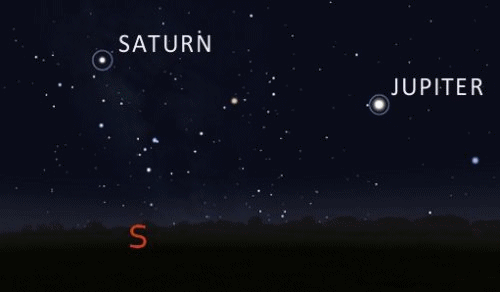
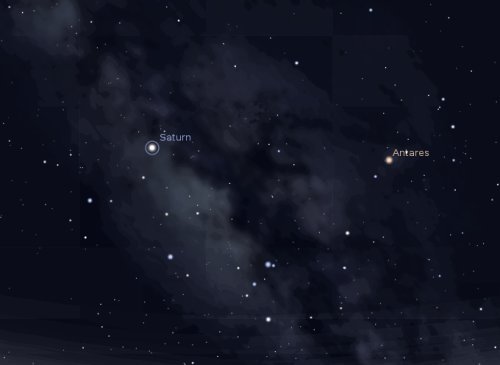

TIP:
Once you have been in the dark for a few minutes, your eyes will slowly adapt to the low light conditions and you will begin to see faint objects that were not visible previously. At this point, any light that is white or yellow in color will ruin this "night vision" that you have temporarily acquired. Those who enjoy star-gazing on a regular basis often cover their flashlights with a reddish filter after they have reached their star-gazing location. Red-filtered lighting can be achieved several ways:
- Commercially-made red filters can be purchased at many stores that sell hiking/camping supplies. Sometimes they are sold individually, and sometimes they are sold with a flashlight.
- You can save money $$$ on a filter if you can find a plastic bag or a scrap of thin, red cloth. Depending on the thickness, you might have to double-over the material a time or two, then secure it to the end of your flashlight with a rubber band.
- If you plan to star-gaze often, you can set aside a particular flashlight to use outdoors at night and paint-over the end of it with red nail polish. Wait a few minutes for it to dry, then add another coat, and repeat until it is as dim as you wish for it to be.


 😊
😊SOURCES
1 Stellarium.org
2 Wikipedia: Astronomy
3 Wikipedia: Astrology
4 Wikipedia: Jupiter
5 Wikipedia: Mars
6 Wikipedia: Milky Way
7 Wikipedia: Saturn






Congratulations! This excellent post was chosen by the new curation initiative of the @postpromoter content promotion service to receive a free upvote!
This post exemplifies the type of great content that we at @postpromoter enjoy reading and would love to see more of on the Steem platform. Keep up the good work!
Downvoting a post can decrease pending rewards and make it less visible. Common reasons:
Submit
Downvoting a post can decrease pending rewards and make it less visible. Common reasons:
Submit
well-deserved, my dear. ;)
Downvoting a post can decrease pending rewards and make it less visible. Common reasons:
Submit
Hell yeah! Glad you got the Super Cool Science presentation for whaleshares tonight while I'm busy slaving away for The Steem House!
I used to live out in the country, and you can see SO much out there away from the light pollution... I loved sitting out in the middle of nowhere, just staring at the pretty lights.
Downvoting a post can decrease pending rewards and make it less visible. Common reasons:
Submit
Love space stuff, thank you for this post, software has been downloaded :-)
Downvoting a post can decrease pending rewards and make it less visible. Common reasons:
Submit
The beginning of your story reminded me the movie contact, Interesting information about Venus. Great post!
Downvoting a post can decrease pending rewards and make it less visible. Common reasons:
Submit
I LOVE that movie! Arrival is pretty good too, little newer though..
Downvoting a post can decrease pending rewards and make it less visible. Common reasons:
Submit
Downvoting a post can decrease pending rewards and make it less visible. Common reasons:
Submit
Okay, took me a while to get to reading it. But i'm wowed!
Wow you had fun as a kid! So much stuff i probably didn't know of when i was at that age.
This was an amazing read dear, didn't realize you had an astronomer in you. I've been away for too long. The heavens are intriguing and quite vast to get a hang on easily. i've seen the constellation charts and all that a couple of times and i'm not sure i could tell which one was which.
It'll be a great idea to visit space someday, been a silent dream for me. Maybe someday, Saturn looks glorious on the images i've seen so far. i'll get my own telescope too to get the view of things beforehand.someday.
PS, i recently started a series on the solar system, and i kicked off by giving a brief description of the planets and described the sun and how it gets its energy. It would be an honour if you check to see if there's something i might have missed. Overview of the solar system aaand... The sun
Downvoting a post can decrease pending rewards and make it less visible. Common reasons:
Submit
You have such a cool life!
....so many cool hobbies and loves!
Downvoting a post can decrease pending rewards and make it less visible. Common reasons:
Submit
Hi your post has been upvoted by vis4, the LGBT+ curation bot! Come and visit us on Discord
Downvoting a post can decrease pending rewards and make it less visible. Common reasons:
Submit
Team Good Alpaca loves this post! Nomnomnomnom!

Delegate to our project via SteemConnect:
10 SP | 20 SP | 50 SP | 100 SP | 200 SP | 500 SP | 1000 SP | 5000 SP
Downvoting a post can decrease pending rewards and make it less visible. Common reasons:
Submit
I love reading your post as I too am hooked to watch the skies with my telescope.
Stellarium is my favourite app. And it is a great tool for every beginner .
Downvoting a post can decrease pending rewards and make it less visible. Common reasons:
Submit
I love this post! You really made it shine and good job with those animations! Everything here looks so cute and is really educational and interesting to read 💚
Downvoting a post can decrease pending rewards and make it less visible. Common reasons:
Submit
Wasn't aware of this so cool! Very informative! Upvoted :)
Downvoting a post can decrease pending rewards and make it less visible. Common reasons:
Submit
This is absolutely fantastic, KittyGirl! Now I find myself wishing I had a proper telescope, or that I had the patience to build one myself!
I love how you began this post – with a little glimpse into your childhood. I always enjoy knowing how a person came to love something, especially when combined with subsequent stories of how that passion unfolded.
Thank you for sharing the wonders of the night sky with us! You also made me hungry with this:
Some 'sparkly' goodness for you – frozen raindrops in the sunshine!
Downvoting a post can decrease pending rewards and make it less visible. Common reasons:
Submit
You got a 9.84% upvote from @postpromoter courtesy of @postcurator!
Want to promote your posts too? Check out the Steem Bot Tracker website for more info. If you would like to support the development of @postpromoter and the bot tracker please vote for @yabapmatt for witness!
Downvoting a post can decrease pending rewards and make it less visible. Common reasons:
Submit
Interesting read. Thanks for this interesting information. I've always been fascinated by the size of the universe - show how truly small we as humans actually are!!
Downvoting a post can decrease pending rewards and make it less visible. Common reasons:
Submit
This post has been voted on by the steemstem curation team and voting trail.
There is more to SteemSTEM than just writing posts, check here for some more tips on being a community member. You can also join our discord here to get to know the rest of the community!
Downvoting a post can decrease pending rewards and make it less visible. Common reasons:
Submit
Hi @thekittygirl!
Your post was upvoted by utopian.io in cooperation with steemstem - supporting knowledge, innovation and technological advancement on the Steem Blockchain.
Contribute to Open Source with utopian.io
Learn how to contribute on our website and join the new open source economy.
Want to chat? Join the Utopian Community on Discord https://discord.gg/h52nFrV
Downvoting a post can decrease pending rewards and make it less visible. Common reasons:
Submit
What an excellent post! I love star gazing as well but I haven't for quite some time. Down at the lake I had an old reflector type telescope that I traded some repair work for. My hubby made me a flashlight by swapping out the white l.e.d. bulb with a red one......I was surprised how well I could see with it.
I'm always amazed by your knowledge! I think being part of your Astronomy club would have been so much fun! I enjoyed stamp club but this would have been much more fun! LOL!
Downvoting a post can decrease pending rewards and make it less visible. Common reasons:
Submit
Oh, my, what an extensive article. So very interesting! Thank you for sharing all this information and knowledge you have about this subject matter. I am so impressed with you, my friend!
Downvoting a post can decrease pending rewards and make it less visible. Common reasons:
Submit
This is excellent information and makes me want to become a star gazer. With my glasses and stigmatism and such, I always have a hard time focusing binoculars.
You made it sound so interesting. I wished I would have been in your club!!
And the DIY telescope - love it!!
Downvoting a post can decrease pending rewards and make it less visible. Common reasons:
Submit
How awesome that such a small assignment led to a lifetime fascination! My son and husband built a homemade telescope at one point as well, but then they found an incredible deal on a HUGE telescope at a garage sale that came with tons of extras and spent hours with it.
I seriously just love that you can trace back this hobby/passion back to childhood reading!
Downvoting a post can decrease pending rewards and make it less visible. Common reasons:
Submit
You can make planets out of stars because they don't twinkle :)
I'm glad to see the post did so well, so beautiful edited
I'm also a stargazer
Downvoting a post can decrease pending rewards and make it less visible. Common reasons:
Submit
Thanks for helping those of us wanting to learn more about star gazing. I have to find a nice hill away from lights to do any with a telescope due to street lights near my house, but I plan on getting back into more of my learning of the universe and you helped out with finding planets easier! (Venus I already had an idea about)
Downvoting a post can decrease pending rewards and make it less visible. Common reasons:
Submit